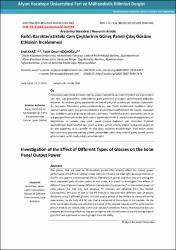Farklı karakteristikteki cam çeşitlerinin güneş paneli çıkış gücüne etkisinin incelenmesi
Citation
Ayaz, E. & Hocaoğlu, F. O. (2020). Farklı Karakteristikteki Cam Çeşitlerinin Güneş Paneli Çıkış Gücüne Etkisinin İncelenmesi . Afyon Kocatepe Üniversitesi Fen Ve Mühendislik Bilimleri Dergisi , 20 (3) , 434-440 . DOI: 10.35414/akufemubid.662919Abstract
Fotovoltaik panellerde kullanılan camlar, güneş hücrelerini çevresel etmenlere karşı korumanın
yanı sıra, ışığı geçirebilme kabiliyetlerine göre panellerin çıkış gücü performansını doğrudan
etkilerler. Bu nedenle güneş panellerinin en önemli parçaları arasında yer aldıkları söylenebilir.
Bu çalışmada, fotovoltaik güneş panellerinde yer alan “farklı karakteristik özelliklere sahip”
camların güneş paneli çıkış gücüne etkilerinin araştırılması hedeflenmiştir. Bu amaçla, piyasadan
aynı özelliklere sahip iki güneş paneli temin edilmiştir. Panellerden birinin üzerindeki cam, ısı ve
ışık geçirgenlikleri birbirinden farklı camlar (birbirinden farklı 3 cam kullanılarak değiştirilmiş) ile
değiştirilmiş ve panelin çıkış gücü, panel çıkışına bağlanan yük üzerinden ölçülerek
kaydedilmiştir. Diğer taraftan aynı ışınım ve ortam şartları altında, orijinal camlı panel çıkışına da
bir yük bağlanmış ve bu panelin de çıkış gücü ölçülerek kaydedilmiştir. Elde edilen veriler
karşılaştırılarak optimize edilmiş yüksek geçirgenliğe sahip olan, orijinal güneş paneli camına
göre ne kadar verim kaybı olduğu yorumlanmıştır The glasses that are used on Photovoltaic panels (PV), directly affect the output power
performance of the PVs according to their ability to transmit the solar light, beside protection of
the PV cells against environmental effects. Therefore, it can be said that they are among the
most important parts of solar panels. In this study, it is aimed to investigate “the effects of
different type of glasses having different characteristically properties” on the output power of
solar panels. For this aim, two identical PV modules are obtained from the market.
Consequently, the glass of one of the PV module is replaced with different type of glasses
(Replaced using 3 different glasses) and the output power of the module is measured during
experiments, by the help of a DC load that is connected at the output of the module. On the
other hand, same load is connected to the output of the original module and the performances
of each module are tested under same solar radiation conditions. Finally, the measured data are
analyzed and the total efficiency lose are compared with the efficiency of the PV having original
glass that was optimized to have high light transmit ability.
Source
MakaleVolume
20Issue
3URI
https://dergipark.org.tr/tr/download/article-file/1172616https://doi.org/10.35414/akufemubid.662919
https://hdl.handle.net/11630/9667



















